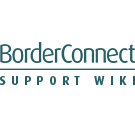Customs Compliance Guide (CBP and CBSA): Difference between revisions
| Line 77: | Line 77: | ||
== Do-It-Yourself Customs Consulting Guide == | == Do-It-Yourself Customs Consulting Guide == | ||
Learn How To Cross Commercially Into the U.S. and Canada as a Highway Carrier. The DIY Customs Consulting Guide focuses on everything from getting started to cross into the U.S and Canada as a commercial highway carrier to what documentation is required and what programs you need to register for in order to cross. | |||
=== Crossing Into Canada === | === Crossing Into Canada === | ||
Revision as of 12:55, 9 June 2023
| This article is part of the Customs Compliance Guide |

The BorderConnect Customs Compliance Guide is intended to provide basic knowledge to highway carriers who cross the border into Canada and the United States commercially and are looking for information on specific ports and specific compliance programs. For information on ACE Manifest, visit the BorderConnect ACE Manifest Software User Guide, or for information on ACI eManifest, visit the ACI eManifest Software User Guide.
For more advanced information on the process involved with getting started crossing the border, or to get set up for any specific customs compliance programs, visit BorderConnect Do-It-Yourself Customs Consulting, or contact BorderConnect toll-free at 1-800-596-5176.
Crossing Into the U.S. (CBP)
In order to cross commercially into the United States, the carrier will need to register with the Department of Transportation where the carrier must get a US DOT or MC number. Once a DOT number has been assigned the carrier must then register their company with National Motor Freight Traffic Association (NMFTA.org) to get a valid Standard Carrier Alpha Code (SCAC).
Once the carrier has a valid Standard Carrier Alpha Code the carrier can then move forward in ordering barcode labels and processing ACE electronic manifests.
Below are helpful articles that cover the process of crossing commercially into the United States:
- US Customs and Border Protection - Information
- Standard Carrier Alpha Code (CBP)
- ACE Manifest Software User Guide (CBP)
- CBP Highway Port Listing
- Shipment Release Types for CBP
- Customs Glossary
U.S. Customs Compliance Documents (CBP)
- Application for SCAC Code
- Application for US DOT Number (MCS-150C)
- Application for Motor Carrier Number (OP-1)
- CBP Form 3299 (Personal Shipment)
- CBP Form 7523 (Free of Duty)
- CBP Form 3311 (Returned American Products)
Crossing Into Canada (CBSA)
In order to cross commercially into Canada, the carrier will need to register with the specific provincial transportation authority as a commercial carrier. In Ontario this is done through the Ministry of Transportation with a CVOR or (Commercial Vehicle Operators Registration). Once a carrier and driver is registered with a CVOR, the company will then apply for a Bonded or Non-Bonded Carrier Code with Canada Border Services Agency. This Carrier Code is a 4-character unique company identifier for use with cross-border shipments.
Once the carrier code is valid, the carrier can then create barcode labels and register to process ACI eManifests.
Below are helpful articles that cover the process of crossing commercially into Canada:
- Canada Border Services Agency - Information
- Canadian Carrier Code (CBSA)
- ACI eManifest Software User Guide (CBSA)
- CBSA Highway Port Listing
- Shipment Release Types for CBSA
- Customs Glossary
Canadian Customs Compliance Documents (CBSA)
- CVOR Information (MTO)
- Commercial Vehicle Operators Registration (CVOR)
- Application for Carrier Code (BSF329-7)
- Changing Bond Status for Existing Carriers (BSF722)
- Temporary Admission Permit (E29B)
- Manual Correction Form - Post Arrival (BSF673)
Trusted Trader Programs
Free and Secure Trade (FAST), is a joint initiative between CBP and CBSA designed to enhance border security while speeding up the processing of low risk shipments. Carriers that are FAST approved for the U.S. are able to transport FAST shipments, and are afforded special processing at the border including dedicated lanes and front of line line processing in the case of inspections.
- FAST (Free and Secure Trade) - Information
- Free and Secure Trade (FAST) Program - CBSA
- FAST Commercial Driver Application (E673)
Customs Self Assessment (CSA) allows for the clearance of goods imported by a CSA Approved importer and transported by a CSA Approved carrier. For a shipment to clear under CSA both the importer and carrier must be CSA Approved, and the driver must be registered with either the Commercial Driver Registration Program (CDRP) or the Free And Secure Trade (FAST) driver registration program.
Partners in Protection (PIP) is a cooperative program between private industry and the CBSA aimed at enhancing border and trade chain security. This voluntary program has no membership fee. It is designed to streamline and make border processes more efficient for low-risk, pre-approved businesses recognized as trusted traders.
Customs-Trade Partnership Against Terrorism (C-TPAT) is a voluntary public-private sector supply chain security program led by U.S. Customs and Border Protection (CBP). Through this program, CBP works with the trade community to strengthen international supply chains and improve United States border security.
Do-It-Yourself Customs Consulting Guide
Learn How To Cross Commercially Into the U.S. and Canada as a Highway Carrier. The DIY Customs Consulting Guide focuses on everything from getting started to cross into the U.S and Canada as a commercial highway carrier to what documentation is required and what programs you need to register for in order to cross.
